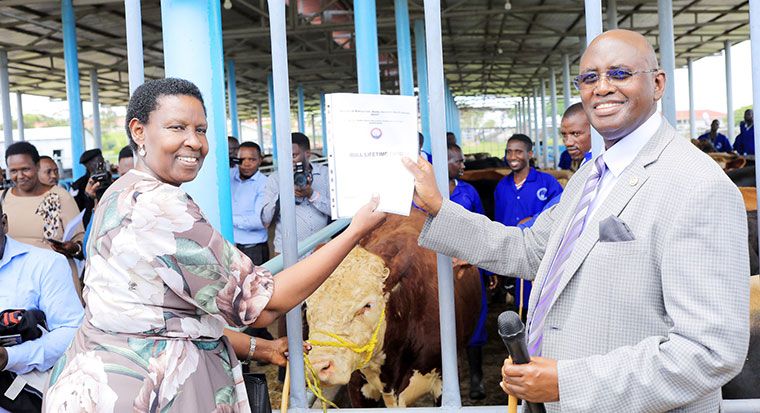
NAGRC&DB inaugurates new board, rolls out 100 dairy bulls
Ben Anyama is the new board chairman of the NationalAnimalGenetics Resources Centre and Data Bank (NAGRC&DB). Dr Bright Rwamirama, the state minister for Animal Industry, introduced the new board on October 17 while officiating at the handover of 100 bulls to the beneficiary farmers following the official inaugural ceremony of the new board of directors of NAGRC&DB in Entebbe.
The board members include Dr Bilal Cabral Kibedi, Dr Henry Aaron Mulindwa, Teddy Alako and Dr Anna Rose Okurut Ademun. Others are Dr Herman Ssekiwunga, Dr Richard Urri Akule, Eng Robert Wajja Ssenozi, Anthony Raymond Epel, Sheila Mwine Kabeije and Dr Samuel Kanakulya Lubinga. Dr Peter Beine, the executive director, is the board secretary.
In his remarks, Rwamirama cautioned the new board to work cohesively, drawing on the members’ individual strengths and expertise to guide NAGRC&DB in fulfilling its mandate.
“Your decisions and actions will play a pivotal role in shaping the future of our animal genetics sector. Let us all embrace this journey with dedication and a shared vision for the prosperity of our nation’s agriculture. Together, we can achieve milestones for the benefit of our farmers, our livestock, and the entire agricultural landscape,” he said.
Later, Rwamirama commissioned the release of 100 assorted superior dairy breeding bulls to farmers who are members of dairy cooperatives identified across the country. According to Beine, this is a routine program of the centre and is conducted at al list 15 animal genetic resources centres located in different agro-ecological zones across the country.
“NAGRC&DB has a two-fold mandate: to play a leading role in the commercialization of animal breeding activities in Uganda; and to carry out development activities that enhance animal genetic improvement and productivity,” he said.
15 REGIONAL FARMS
Apart from the 15 regionally-situated centre farms and ranches, NAGRC&DB also addresses its mandate with a National Poultry Development Centre (NPDC), a five-tonne-per-hour animal feed production plant, the National Bull Stud and Semen Production Center at Entebbe and three liquid nitrogen production plants which service the entire country.
Others include eight regional community breeding satellite centres that facilitate access to artificial breeding services by farmers at the grassroots and an embryo-transfer services unit. Accordingly, NAGRC&DB breeds, multiplies and sells to the public, quality and affordable animal seed at subsidized prices.
These include breeding stock of dairy and beef cattle, goats, poultry, pigs, fish fingerlings, semen for breed improvement programs as well as embryos for pure-breed multiplication.
The role that livestock plays as a sure guarantor against poverty within poor and vulnerable communities in Uganda and the mass awareness campaigns that have been conducted about the same has created a huge demand for high-quality breeding stock for dairy cattle, beef cattle, goats, pigs, multi-purpose poultry and fish fingerlings.
In order for successful implementation of government programs like the Parish Development Model (PDM) that promote livestock farming, the supply of this breeding stock has to be assured and this is where NAGRC&DB centres are positioned to meet this growing demand.
Anyama adds that through its flagship program – the Community Based Breeding Outreach Program (CBBOP), for instance, NAGRC&DB has played a cardinal role in the 190 per cent increase in milk production registered in the country.
“Pig and poultry farmers have also greatly benefitted from the multiplication programs of these genetics at the NAGRC&DB centres contributing to increased household incomes and nutrition security. These continuous animal genetic improvement efforts by the Centre are aimed at realizing a critical mass of resilient and highly productive dairy and meat animals within the livestock communities across the country and steady growth of the animal industry.”
HIGH PEDIGREE BULLS
The current batch of bulls being sold comprise of pure Jersey, Ayrshire, Friesian and Simmental breeds. The pedigree (parentage performance) of each of these bulls indicate exceptional breed traits such as above-average milk production, high milk solids and other important dairy traits like ease of calving, early maturing and longevity in the herd.
It is anticipated that farmers looking to have these traits namely faster growth, increased milk production and milk solids, assured fast calf growth, ease of calving and longevity in the herd and ease of management (higher efficiency of feed conversion) shall benefit greatly from these bulls.
Furthermore, these high-value bulls are being availed to the farmers at a subsidized price (Shs 1,5m) which, according to Beine, is between 50 per cent and 75 per cent of their local market value. Beine adds that they follow the institutional policy on availing genetics to the public and adherer to the Public Procurement and Disposal of Public Assets Authority (PPDA) guidelines while selecting the beneficiaries.
The current beneficiaries were chosen through a competitive process using the PPDA asset disposal methods, guidelines and regulations. Additionally, the agency uses these programs to generate non-tax revenue (NTR) for the consolidated fund as obligated.
“We encourage the public to come to NAGRC&DB for these and other genetics when adverts are made about their availability,” he says.
“It is our mission to improve the national herd and flocks through availing such well-recorded genetics with an assurance that they shall cause the desired improvement in farm production and productivity at the destination farms.”
